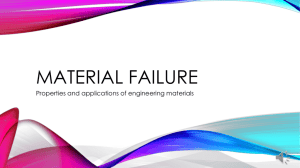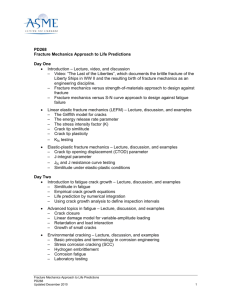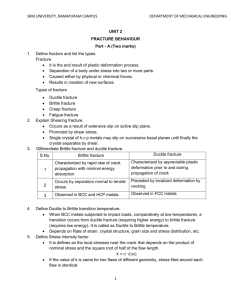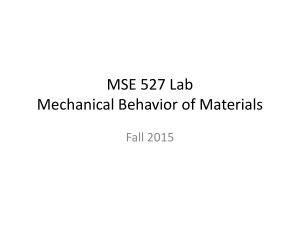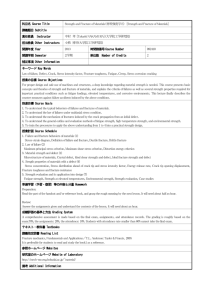Chapter 8. Failure - University of Virginia
advertisement
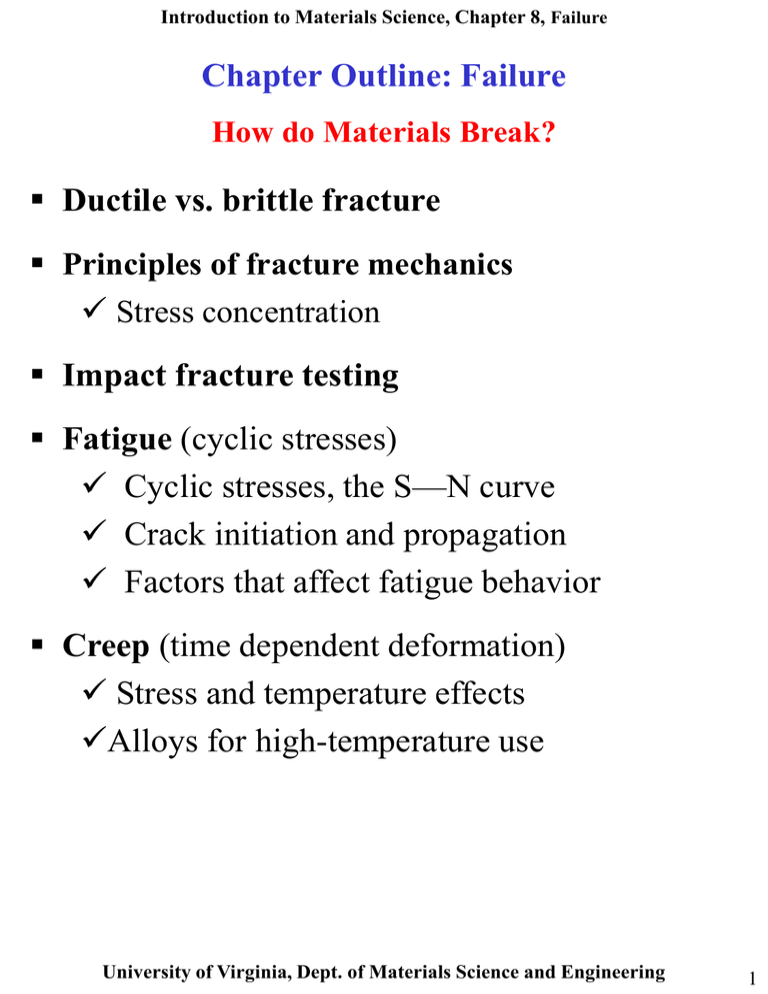
Introduction to Materials Science, Chapter 8, Failure Chapter Outline: Failure How do Materials Break? Ductile vs. brittle fracture Principles of fracture mechanics Stress concentration Impact fracture testing Fatigue (cyclic stresses) Cyclic stresses, the S—N curve Crack initiation and propagation Factors that affect fatigue behavior Creep (time dependent deformation) Stress and temperature effects Alloys for high-temperature use University of Virginia, Dept. of Materials Science and Engineering 1 Introduction to Materials Science, Chapter 8, Failure Brittle vs. Ductile Fracture • Ductile materials - extensive plastic deformation and energy absorption (“toughness”) before fracture • Brittle materials - little plastic deformation and low energy absorption before fracture University of Virginia, Dept. of Materials Science and Engineering 2 Introduction to Materials Science, Chapter 8, Failure Brittle vs. Ductile Fracture A B C A. Very ductile: soft metals (e.g. Pb, Au) at room T, polymers, glasses at high T B. Moderately ductile fracture typical for metals A. Brittle fracture: ceramics, cold metals, University of Virginia, Dept. of Materials Science and Engineering 3 Introduction to Materials Science, Chapter 8, Failure Fracture Steps : crack formation crack propagation Ductile vs. brittle fracture Ductile fracture is preferred in most applications • Ductile - most metals (not too cold): Extensive plastic deformation before crack Crack resists extension unless applied stress is increased • Brittle fracture - ceramics, ice, cold metals: Little plastic deformation Crack propagates rapidly without increase in applied stress University of Virginia, Dept. of Materials Science and Engineering 4 Introduction to Materials Science, Chapter 8, Failure Ductile Fracture (Dislocation Mediated) Crack grows 90o to applied stress 45O maximum shear stress (a) Necking, (b) Cavity Formation, (c) Cavities coalesce form crack (d) Crack propagation, (e) Fracture University of Virginia, Dept. of Materials Science and Engineering 5 Introduction to Materials Science, Chapter 8, Failure Ductile Fracture (Cup-and-cone fracture in Al) Scanning Electron Microscopy. Spherical “dimples” micro-cavities that initiate crack formation. University of Virginia, Dept. of Materials Science and Engineering 6 Introduction to Materials Science, Chapter 8, Failure Brittle Fracture (Low Dislocation Mobility) Crack propagation is fast Propagates nearly perpendicular to direction of applied stress Often propagates by cleavage breaking of atomic bonds along specific crystallographic planes No appreciable plastic deformation Brittle fracture in a mild steel University of Virginia, Dept. of Materials Science and Engineering 7 Introduction to Materials Science, Chapter 8, Failure Brittle Fracture A. Transgranular fracture: Cracks pass through grains. Fracture surface: faceted texture because of different orientation of cleavage planes in grains. B. Intergranular fracture: Crack propagation is along grain boundaries (grain boundaries are weakened/ embrittled by impurity segregation etc.) A B University of Virginia, Dept. of Materials Science and Engineering 8 Introduction to Materials Science, Chapter 8, Failure Stress Concentration Fracture strength of a brittle solid: related to cohesive forces between atoms. Theoretical strength: ~E/10 Experimental strength ~ E/100 - E/10,000 Difference due to: Stress concentration at microscopic flaws Stress amplified at tips of micro-cracks etc., called stress raisers Figure by N. Bernstein & D. Hess, NRL University of Virginia, Dept. of Materials Science and Engineering 9 Introduction to Materials Science, Chapter 8, Failure Stress Concentration Crack perpendicular to applied stress: maximum stress near crack tip a m 2 0 t 1/ 2 0 = applied stress; a = half-length of crack; t = radius of curvature of crack tip. 1/ 2 a m Kt 2 Stress concentration factor 0 t University of Virginia, Dept. of Materials Science and Engineering 10 Introduction to Materials Science, Chapter 8, Failure Impact Fracture Testing Two standard tests: Charpy and Izod. Measure the impact energy (energy required to fracture a test piece under an impact load), also called the notch toughness. Izod Charpy h h’ Energy ~ h - h’ University of Virginia, Dept. of Materials Science and Engineering 11 Introduction to Materials Science, Chapter 8, Failure Ductile-to-Brittle Transition As temperature decreases a ductile material can become brittle University of Virginia, Dept. of Materials Science and Engineering 12 Introduction to Materials Science, Chapter 8, Failure Ductile-to-brittle transition Low temperatures can severely embrittle steels. The Liberty ships, produced in great numbers during the WWII were the first all-welded ships. A significant number of ships failed by catastrophic fracture. Fatigue cracks nucleated at the corners of square hatches and propagated rapidly by brittle fracture. University of Virginia, Dept. of Materials Science and Engineering 13 Introduction to Materials Science, Chapter 8, Failure “Dynamic" Brittle-to-Ductile Transition (not tested) (molecular dynamics simulation ) Ductile Brittle V. Bulatov et al., Nature 391, #6668, 669 (1998) University of Virginia, Dept. of Materials Science and Engineering 14 Introduction to Materials Science, Chapter 8, Failure Fatigue Failure under fluctuating stress Under fluctuating / cyclic stresses, failure can occur at lower loads than under a static load. 90% of all failures of metallic structures (bridges, aircraft, machine components, etc.) Fatigue failure is brittle-like – even in normally ductile materials. Thus sudden and catastrophic! University of Virginia, Dept. of Materials Science and Engineering 15 Introduction to Materials Science, Chapter 8, Failure Fatigue: Cyclic Stresses Characterized by maximum, minimum and mean Range of stress, stress amplitude, and stress ratio Mean stress m = (max + min) / 2 Range of stress r = (max - min) Stress amplitude a = r/2 = (max - min) / 2 Stress ratio R = min / max Convention: tensile stresses positive compressive stresses negative University of Virginia, Dept. of Materials Science and Engineering 16 Introduction to Materials Science, Chapter 8, Failure Fatigue: S—N curves (I) Rotating-bending test S-N curves S (stress) vs. N (number of cycles to failure) Low cycle fatigue: small # of cycles high loads, plastic and elastic deformation High cycle fatigue: large # of cycles low loads, elastic deformation (N > 105) University of Virginia, Dept. of Materials Science and Engineering 17 Introduction to Materials Science, Chapter 8, Failure Fatigue: S—N curves (II) Fatigue limit (some Fe and Ti alloys) S—N curve becomes horizontal at large N Stress amplitude below which the material never fails, no matter how large the number of cycles is University of Virginia, Dept. of Materials Science and Engineering 18 Introduction to Materials Science, Chapter 8, Failure Fatigue: S—N curves (III) Most alloys: S decreases with N. Fatigue strength: Stress at which fracture occurs after specified number of cycles (e.g. 107) Fatigue life: Number of cycles to fail at specified stress level University of Virginia, Dept. of Materials Science and Engineering 19 Introduction to Materials Science, Chapter 8, Failure Fatigue: Crack initiation+ propagation (I) Three stages: 1. crack initiation in the areas of stress concentration (near stress raisers) 2. incremental crack propagation 3. rapid crack propagation after crack reaches critical size The total number of cycles to failure is the sum of cycles at the first and the second stages: Nf = Ni + Np Nf : Number of cycles to failure Ni : Number of cycles for crack initiation Np : Number of cycles for crack propagation High cycle fatigue (low loads): Ni is relatively high. With increasing stress level, Ni decreases and Np dominates University of Virginia, Dept. of Materials Science and Engineering 20 Introduction to Materials Science, Chapter 8, Failure Fatigue: Crack initiation and propagation (II) Crack initiation: Quality of surface and sites of stress concentration (microcracks, scratches, indents, corners, dislocation slip steps, etc.). interior Crack propagation I: Slow propagation along crystal planes with high resolved shear stress. Involves a few grains. Flat fracture surface II: Fast propagation perpendicular to applied stress. Crack grows by repetitive blunting and sharpening process at crack tip. Rough fracture surface. Crack eventually reaches critical dimension and propagates very rapidly University of Virginia, Dept. of Materials Science and Engineering 21 Introduction to Materials Science, Chapter 8, Failure Factors that affect fatigue life Magnitude of stress Quality of the surface Solutions: Polish surface Introduce compressive stresses (compensate for applied tensile stresses) into surface layer. Shot Peening -- fire small shot into surface High-tech - ion implantation, laser peening. Case Hardening: Steel - create C- or N- rich outer layer by atomic diffusion from surface Harder outer layer introduces compressive stresses Optimize geometry Avoid internal corners, notches etc. University of Virginia, Dept. of Materials Science and Engineering 22 Introduction to Materials Science, Chapter 8, Failure Factors affecting fatigue life Environmental effects Thermal Fatigue. Thermal cycling causes expansion and contraction, hence thermal stress. Solutions: change design! use materials with low thermal expansion coefficients Corrosion fatigue. Chemical reactions induce pits which act as stress raisers. Corrosion also enhances crack propagation. Solutions: decrease corrosiveness of medium add protective surface coating add residual compressive stresses University of Virginia, Dept. of Materials Science and Engineering 23 Introduction to Materials Science, Chapter 8, Failure Creep Time-dependent deformation due to constant load at high temperature (> 0.4 Tm) Examples: turbine blades, steam generators. Creep test: Furnace University of Virginia, Dept. of Materials Science and Engineering 24 Introduction to Materials Science, Chapter 8, Failure Stages of creep 1. Instantaneous deformation, mainly elastic. 2. Primary/transient creep. Slope of strain vs. time decreases with time: work-hardening 3. Secondary/steady-state creep. Rate of straining constant: work-hardening and recovery. 4. Tertiary. Rapidly accelerating strain rate up to failure: formation of internal cracks, voids, grain boundary separation, necking, etc. University of Virginia, Dept. of Materials Science and Engineering 25 Introduction to Materials Science, Chapter 8, Failure Parameters of creep behavior Secondary/steady-state creep: Longest duration Long-life applications s / t Time to rupture ( rupture lifetime, tr): Important for short-life creep /t tr University of Virginia, Dept. of Materials Science and Engineering 26 Introduction to Materials Science, Chapter 8, Failure Creep: stress and temperature effects With increasing stress or temperature: The instantaneous strain increases The steady-state creep rate increases The time to rupture decreases University of Virginia, Dept. of Materials Science and Engineering 27 Introduction to Materials Science, Chapter 8, Failure Creep: stress and temperature effects Stress/temperature dependence of the steady-state creep rate can be described by Qc s K 2 exp RT n Qc = activation energy for creep K2 and n are material constants University of Virginia, Dept. of Materials Science and Engineering 28 Introduction to Materials Science, Chapter 8, Failure Mechanisms of Creep Different mechanisms act in different materials and under different loading and temperature conditions: Stress-assisted vacancy diffusion Grain boundary diffusion Grain boundary sliding Dislocation motion Different mechanisms different n, Qc. Grain boundary diffusion Dislocation glide and climb University of Virginia, Dept. of Materials Science and Engineering 29 Introduction to Materials Science, Chapter 8, Failure Alloys for High-Temperatures (turbines in jet engines, hypersonic airplanes, nuclear reactors, etc.) Creep minimized in materials with High melting temperature High elastic modulus Large grain sizes (inhibits grain boundary sliding) Following materials (Chap.12) are especially resilient to creep: Stainless steels Refractory metals (containing elements of high melting point, like Nb, Mo, W, Ta) “Superalloys” (Co, Ni based: solid solution hardening and secondary phases) University of Virginia, Dept. of Materials Science and Engineering 30 Introduction to Materials Science, Chapter 8, Failure Summary Make sure you understand language and concepts: Brittle fracture Charpy test Corrosion fatigue Creep Ductile fracture Ductile-to-brittle transition Fatigue Fatigue life Fatigue limit Fatigue strength Impact energy Intergranular fracture Izod test Stress raiser Thermal fatigue Transgranular fracture University of Virginia, Dept. of Materials Science and Engineering 31

